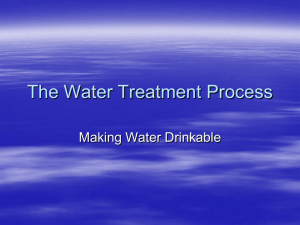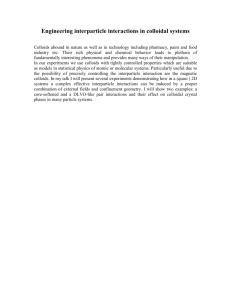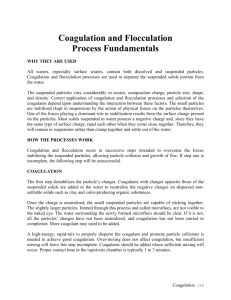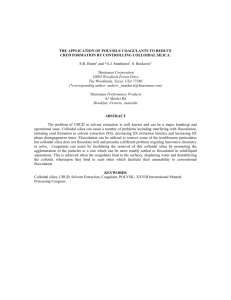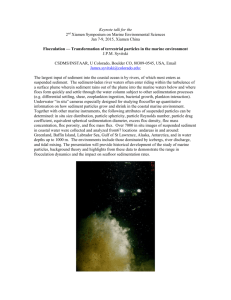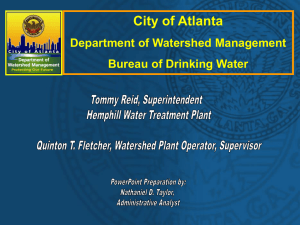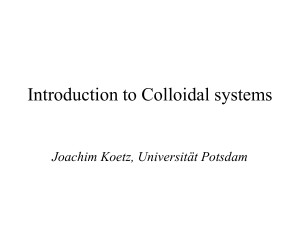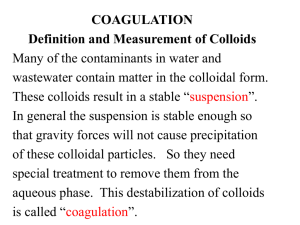CoagFloc
advertisement
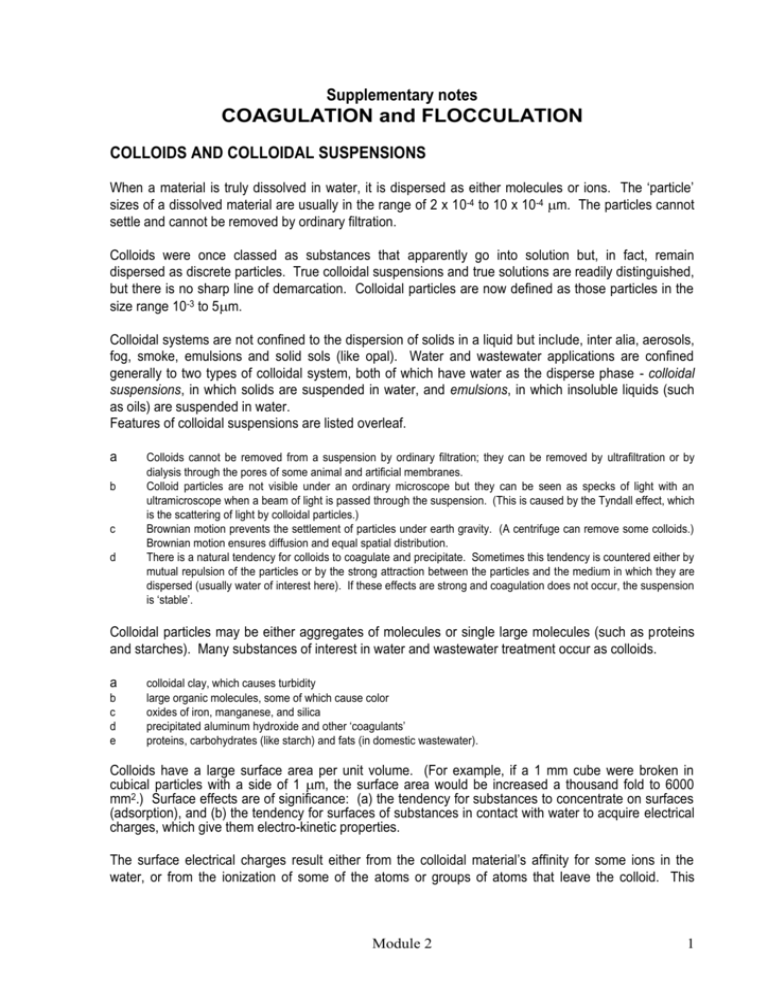
Supplementary notes
COAGULATION and FLOCCULATION
COLLOIDS AND COLLOIDAL SUSPENSIONS
When a material is truly dissolved in water, it is dispersed as either molecules or ions. The ‘particle’
sizes of a dissolved material are usually in the range of 2 x 10-4 to 10 x 10-4 m. The particles cannot
settle and cannot be removed by ordinary filtration.
Colloids were once classed as substances that apparently go into solution but, in fact, remain
dispersed as discrete particles. True colloidal suspensions and true solutions are readily distinguished,
but there is no sharp line of demarcation. Colloidal particles are now defined as those particles in the
size range 10-3 to 5m.
Colloidal systems are not confined to the dispersion of solids in a liquid but include, inter alia, aerosols,
fog, smoke, emulsions and solid sols (like opal). Water and wastewater applications are confined
generally to two types of colloidal system, both of which have water as the disperse phase - colloidal
suspensions, in which solids are suspended in water, and emulsions, in which insoluble liquids (such
as oils) are suspended in water.
Features of colloidal suspensions are listed overleaf.
a
b
c
d
Colloids cannot be removed from a suspension by ordinary filtration; they can be removed by ultrafiltration or by
dialysis through the pores of some animal and artificial membranes.
Colloid particles are not visible under an ordinary microscope but they can be seen as specks of light with an
ultramicroscope when a beam of light is passed through the suspension. (This is caused by the Tyndall effect, which
is the scattering of light by colloidal particles.)
Brownian motion prevents the settlement of particles under earth gravity. (A centrifuge can remove some colloids.)
Brownian motion ensures diffusion and equal spatial distribution.
There is a natural tendency for colloids to coagulate and precipitate. Sometimes this tendency is countered either by
mutual repulsion of the particles or by the strong attraction between the particles and the medium in which they are
dispersed (usually water of interest here). If these effects are strong and coagulation does not occur, the suspension
is ‘stable’.
Colloidal particles may be either aggregates of molecules or single large molecules (such as proteins
and starches). Many substances of interest in water and wastewater treatment occur as colloids.
a
b
c
d
e
colloidal clay, which causes turbidity
large organic molecules, some of which cause color
oxides of iron, manganese, and silica
precipitated aluminum hydroxide and other ‘coagulants’
proteins, carbohydrates (like starch) and fats (in domestic wastewater).
Colloids have a large surface area per unit volume. (For example, if a 1 mm cube were broken in
cubical particles with a side of 1 m, the surface area would be increased a thousand fold to 6000
mm2.) Surface effects are of significance: (a) the tendency for substances to concentrate on surfaces
(adsorption), and (b) the tendency for surfaces of substances in contact with water to acquire electrical
charges, which give them electro-kinetic properties.
The surface electrical charges result either from the colloidal material’s affinity for some ions in the
water, or from the ionization of some of the atoms or groups of atoms that leave the colloid. This
Module 2
1
surface charge attracts ions carrying a charge of opposite sign and thus creates a cloud of ‘counterions’ in which the concentration decreases as the distance from the particle increases.
The overall situation is complex. The colloids, which carry similar charges, will repel each other but,
because of the presence of counter-ions, the situation cannot be likened to that of charged particles in
air, where an inverse square law applies. In particular, the presence of the counter-ions complicates
the law relating the degree of repulsion between colloidal particles, causing a more rapid fall-off in
repulsive force as distance increases.
In addition to the forces related to the electrical charges, colloidal particles, when close together, are
subject to van der Waals forces. These originate in the behavior of electrons that are part of the atomic
or molecular system. They are always forces of attraction, and become significant only at small
distances (e.g. 1m or less).
The forces between charged colloidal particles are represented in the figure below.
The hatched area A represents the energy required to bring two particles close enough so that there is
a net attraction between them so that they may be expected to be drawn together. The source of this
energy may be either impacts from molecules (Brownian motion) or relative movement in the water. If
the energy of an impact is inadequate, the remaining repulsion will again force the particles apart,
resulting in a stable suspension.
2
Module 2
COAGULATION
To destabilize a hydrophobic colloidal suspension during coagulation, it is necessary to reduce the
energy requirement, A, shown in the figure above.
The van der Waals forces cannot be manipulated but the electrical forces can be; the two principal
methods are
a
b
reduce or neutralize the charges on the colloids
increase the density of the counter-ion field, and thus reduce the range of the repulsive effect.
Adjustment of pH
The charge on colloidal surfaces is usually a function of the type of material and the pH. At high values
of pH, colloids tend to be negatively charged, while at low values they tend to be positively charged.
This could be related to exchange of H+ and OH- ions to establish equilibrium with the water at different
pH values.
Neutralizing charges
Neutralizing charges on colloids may be accomplished by the addition of either multivalent ions or
colloids, or both, having an opposite charge. These are frequently added as a chemical coagulant.
The Schultz-Hardy rule indicates that the coagulating power of a chemical rises rapidly with its valance.
For example, Al3+ and SO42- ions are almost 1000 times more effective than Na+ and Cl- ions.
Chemicals commonly used as coagulants in water treatment are aluminum and ferric salts, which
hydrolyze to produce a number of insoluble hydrates (their composition depending on pH, temperature,
other materials present and age). At pH values between 6 and 7, these hydrates form positively
charged colloids and, hence, destabilization is possible.
Other impurities, some of which are responsible for tastes and odors, can be adsorbed onto the
colloids or can be enmeshed in the floccules that form.
COAGULATION CHEMICALS AND DOSING
Chemicals used for coagulation in water treatment not only should be cost-effective for coagulating
impurities but also should not leave any toxic or other undesirable residues in the water.
Aluminum compounds
The common aluminum salt used is aluminum sulfate. As filter alum, it is available either in lump,
granular or powdered form (depending on the local supplier). Filter alum contains a variable amount of
water of crystallization, depending on the local method of manufacture (Al 2(SO4)3.nH2O where n is
usually in the range 14 to 18. As liquid alum, it can be trucked or piped to suitable storages if a
treatment plant is near an alum-producing plant. Liquid alum is often cheaper than crystalline alum but
it requires acid-proof (stainless steel) tanks and piping for storage and transport. It usually contains the
equivalent of about 6 to 8 per cent soluble alumina, compared with about 17 per cent for crystallized
alum. Note that the cost of stainless steel equipment is a magnitude higher than that of ordinary steel.
Module 2
3
There is a limited pH range in which the insoluble aluminum hydrates, such as aluminum hydroxide, will
form from a dilute alum solution. If the pH is too low, a more soluble compound, Al(OH) 2+ will form. If it
is too high, above pH8, the aluminum becomes complexed into Al(OH) 4-. The optimum pH range in a
particular case depends on the nature and concentration of the impurities in the water. For a soft water
containing a considerable amount of color, the optimum pH is likely to be in the range 5.0 to 6.3, but for
turbid water with moderate alkalinity, it is likely to be 6.0 to 7.0.
When hydrolyzed, alum produces sulfuric acid as well as the hydrate; for example, when forming the
simplest hydrate (Al(OH)3) the hydrolysis reaction is
Al2(SO4)3 + 6H2O 2Al(OH)3 + 3H2SO4
It is therefore regarded as an acid salt and the water must contain enough of either natural or added
alkalinity to react with the acid as it forms, thus keeping the resultant pH within the desired range for
good flocculation. Added alkalinity is usually in the form of lime (calcium hydroxide), soda ash (sodium
carbonate) or caustic soda (sodium hydroxide).
Ca(OH)2 + H2SO4 CaSO4 + 2H2O
2Na2CO3 + H2SO4 Na2SO4 + 2NaHCO3
2NaOH + H2SO4 Na2SO4 + 2H2O
It sometimes happens with water having a high alkalinity that large amounts of alum would be required
to reduce the pH to that required for optimum precipitation. In some cases, economy may be obtained
by the use of some sulfuric acid for pH control, in conjunction with an adequate amount of alum to form
a suitable floc.
Sodium aluminate
Sodium aluminate is an alkaline salt manufactured by treating aluminum oxide with caustic soda. The
simple hydrolysis reaction is
NaAlO2 + 2H2O Al(OH)3 + NaOH
It can be used either in conjunction with alum or on its own, in waters which do not have enough
natural alkalinity (that is, where it would be necessary otherwise to correct the coagulation pH by
adding an alkali). However, the resulting coagulation may not be as good as when alum is used with
an alkali, because the divalent sulfate ions introduced with the alum have a favorable influence on
coagulation.
Iron salts
Ferric ions can be hydrolyzed and precipitated as ferric hydroxide in a number of different forms, at pH
values above about 4.5. Good coagulation occurs in the pH range 7 to 8.5.
The ferric ion, like the aluminum ion, hydrolyses to form a range of hydrates and an acid. Enough
alkalinity (natural or added) must be present to combine with the acid and maintain a suitable pH value
for good coagulation, but, unlike aluminum hydroxide, ferric hydroxide does not re-dissolve in alkaline
solutions, and so there is no particular upper pH limit for ferric coagulation. In addition, ferric hydroxide
floc is usually denser, and hence faster settling, than aluminum hydroxide floc.
4
Module 2
The most common ferric salt used for coagulation in water treatment is ferric chloride (FeCl3). It is
commonly available as a liquid containing about 35 per cent FeCl 3 by mass also in a crystalline form
containing 60 per cent FeCl3 by weight, and as an anhydrous powder. Ferric chloride is very corrosive
in the presence of water and, therefore, it must be transported in rubber-lined tanks, glass containers or
PVC drums.
Ferric sulfate (Fe2(SO4)3) is available commercially in some areas as an anhydrous material, which may
be transported and stored in plastic barrels. In the coagulation of colored acid waters, the presence of
the divalent sulfate ion assists coagulation to a greater degree than that of the monovalent chloride ion.
Sometimes ferrous salts are used. To be effective, the ferrous ion should be oxidized to the ferric form
when in solution. At pH values above 8.5, dissolved oxygen in the water will cause oxidation but, at
lower pH values, chlorine can be used as an oxidizing agent. Ferrous sulfate (FeSO4.7H2O), also
known as copperas, is a granular material, which can be purchased in bags or in bulk. Because it
requires a pH of more than 8.5 to be oxidized by dissolved oxygen, it cannot be used on its own in
natural waters. When used in conjunction with lime, it is useful in coagulating the precipitate obtained
in lime softening of water and in removal of excessive iron and manganese from certain groundwaters.
Lime
Lime can be used to destabilize colloidal suspensions and emulsions of organic substances or oils
present in sewage, or effluents from food and engineering industries. Also, by raising the pH, it can
assist in the precipitation of some radioactive and toxic metals as hydroxides. Lime is also used in
softening water, to convert soluble calcium bicarbonates to insoluble calcium carbonate. It is available
in powder form as either burnt lime (calcium oxide, CIO) or slaked lime (calcium hydroxide, Ca(OH) 2).
Because commercial lime contains insoluble impurities and lime is only sparingly soluble (about 0.1%)
in water, lime slurry chambers must be continually stirred and provision must be made for cleaning out
scale which may form in dosing pipelines - rubber pipelines allow easy dislodging.
The calcium introduced by the lime dose is precipitated mostly as calcium carbonate at pH levels of 1010.5. If phosphates are present, they are precipitated as insoluble calcium phosphate. The discrete
particles of precipitated calcium carbonate grow slowly, mainly by direct deposition from a supersaturated solution. Sludge recycling or some other form of ‘solids contact’ is therefore necessary for
effective coagulation and settlement of lime precipitates. Lime dosing also offers the possibility of
softening the water if there is sufficient alkalinity in the water.
Ferric chloride, copperas or alum is sometimes used in conjunction with lime to improve the flocculation
of the particles that are precipitated.
Coagulation aids
In some waters or effluents, coagulation is poor, even with the best dose of coagulant. Sometimes, an
improvement in coagulation - and, consequently, in settling velocity - is desired so that either a plant
may carry peak loads in excess of the original design. The addition of extra substances known as
coagulant aids can often result in considerable improvement in coagulation and an increase in the
settling velocity of the resulting floc. The materials used are mainly clay minerals such as bentonite
and kaolin, polyelectrolytes, alginates and activated silica.
Module 2
5
Chemicals for pH adjustment
On some occasions, it is necessary to increase or decrease the pH of a water or waste, either to obtain
improved coagulation and flocculation or to make the pH of treated water acceptable for discharge.
Apart from the coagulants, which vary the pH of the water, the chemicals commonly used for pH
adjustment are sulfuric acid and carbon dioxide to decrease pH, and soda ash (sodium carbonate),
lime (calcium oxide or hydroxide), or caustic soda (sodium hydroxide) to increase it.
Rapid mixing
It is desirable that coagulants, when added to the water, should be thoroughly and intimately dispersed
throughout the volume of water before a colloidal precipitate is formed. The coagulation reaction is fast
and the demand will be significantly increased if not all colloids are reached by equal concentrations of
coagulant. The amount of reagent solution added is very small in comparison with the main flow of
water. The flow of reagents is not always uniform and continuous, as some metering pumps deliver the
solution in intermittent pulses.
Mixing chambers are often provided to have a detention time of between 30 and 60 seconds at
maximum flow, thus giving adequate backmixing. The reagents should be added to the main flow
either at the inlet to the mixing chamber, or just upstream from the inlet.
Optimum coagulant dose
Cost and performance are the criteria to be optimized. The optimum dose will be the lowest (least cost)
dose which will produce a readily settleable floc to remove turbidity efficiently in a reasonably short
time, remove excess color from the water, and have suitable filterability properties. The speed of
settling of the floc is reflected in the sedimentation design - slower settling means larger tanks with
correspondingly increased capital costs. The speed of formation of the floc is reflected in the
flocculation chamber design. Slow forming flocs require a large flocculation tank to provide adequate
detention time.
Tests should be carried out to determine the best combination of coagulant and pH adjustment, and the
optimum pH for coagulation. A single coagulant may be adequate for coagulation, pH correction may
be required or the addition of coagulation aids to achieve satisfactory performance. These factors
need to be known before a design is prepared for chemical storage and chemical feeding equipment.
In the jar test, different doses of coagulant, and of other chemicals if necessary, are added
simultaneously to several (often six) samples of the water to be treated. Each sample undergoes the
same rapid mixing and slow stirring until a suitable floc is formed.
The jar test apparatus consists of a set of vertical paddles in a row, so arranged that liter or half liter
beakers can be conveniently placed under each paddle. The driving motor has a variable speed
control, and a tachometer indicates the rotational speed of the paddles. A well-diffused light, either
above or below the samples, provides uniform light conditions for observing the floc.
About 0.5 L of water is placed in each of six beakers, which are then placed in position under the
paddles on the jar test machine. Appropriate quantities of coagulant are added during an initial rapid
mix (say 100 rev/min). After about 30 seconds from the first addition of coagulant, the speed is
reduced to that used for flocculation, for example 20 to 50 rev/min for 10 - 20 minutes. Observe the
time from the addition of coagulant to the first appearance of visible, discrete floc particles in each
6
Module 2
beaker, and the time taken for flocs to settle. The effect of pH can be tested for, usually by adding lime
or sodium hydroxide solution prior to adding the coagulants.
A decanted small amount of the settled water from the top of each beaker can be used for
determination of color, turbidity, pH and alkalinity.
FLOCCULATION
When a colloid has been destabilized, the growth of flocs due to the agglomeration of the colloidal
particles occurs mainly in two stages, known as perikinetic and orthokinetic flocculation. In the first
stage, particles collide and stick together as they move randomly about under the influence of
Brownian motion. The particles grow so large that Brownian motion no longer significantly affects them
and, in less than a minute, this phase becomes unimportant. The second stage relies on particles
being moved together by gentle induced motion of the water.
The velocity shear gradient, G is the rate of change in velocity, within the liquid, relative to another
point or plane, as a function of the distance between the points or planes, i.e.
G
dV
, where V is the velocity, and y the distance between the points or the planes.
dy
The
dimensions are velocity/distance, i.e. ms-1/m = s-1. The relative velocity between one plane of liquid
and another can be defined as Gh, where h is the distance between the planes.
Estimation of velocity shear gradient
Revision of Physics will show that viscosity, , is a property of a fluid that is a measure of its resistance
to change shape or flow. It is measured as the pressure and time required to cause relative motion
within the fluid. Viscosity is therefore expressed as Pascal seconds (Pa.s) = N.m -2.s, or kg.m.s-2. m-2.s
= kg.m-1.s-1.
The rate of viscous dissipation of energy in a velocity shear gradient field can be readily estimated by
consideration of an element of height, h, and plan area, A, with the upper surface being moved at a
velocity, Gh, relative to the lower surface as shown in Figure 2.2. The horizontal viscous stress is
equal to G, and the viscous shear force is AG.
Figure 2.2 Definition diagram for energy dissipation
The rate of energy dissipation (or rate of work input) is the product of force and distance per time (i.e.
force and velocity difference)and velocity difference and is equal to AG x Gh. This is also the external
power input, P required.
Module 2
7
P = AGxGh = G2
If the shear gradient is uniform, therefore
G=
P
,
;
[2.1]
where G is the velocity gradient (s-1); P is the power dissipation (W); is the volume (m3) and is the
absolute viscosity (N.s/m2) ( 10-3 for water at 20˚C).
Floc rupture
Although the initial rate of floc formation is proportional to the velocity shear gradients, high-velocity
shear gradients can cause flocs to be ripped apart as a result of either internal tension or surface shear
stress erosion, or both.
Although the rate of particle growth can be accelerated by having large values of G when the particles
are small, large particles coming into a zone where G is high can be eroded or ruptured, or both. This
effect limits the size to which floccules will grow - the higher the local maximum G values, the smaller is
the attainable maximum floc size.
Tapered flocculation
Rapid initial flocculation rates can be attained at moderately high G values but with progressively
decreasing G value as it becomes necessary to provide further floc growth without disruption. Such an
arrangement is called tapered flocculation.
An example of this application is shown as in a baffled flocculation chamber (Figure 2.3).
Another approach to tapered flocculation, is to increase flocculator depth or width instead of baffle
spacing.
Figure 2.3 Baffled flocculation channel
Values of G and t
The optimum values of G, the average shear gradient, and t, the flocculation time, depend on the
chemical composition of the water and the nature and amount of colloids present. The optimum G
value tends to decrease with increasing turbidity. Mean G values of between 20 and 100 s -1 and
8
Module 2
flocculation times of 20 to 40 minutes are commonly used. For any water, there is an optimum
combination of G and t.
Camp proposed the product of G and t as a dimensionless number, which could be used to judge the
adequacy of flocculation. Camp numbers, Gt, of between 2 x 10 4 and 2 x 105 are considered to
achieve a satisfactory flocculation.
The zones of satisfactory performance are different for waters from different sources. In extreme
cases, the zones for two different waters may not overlap. An indication of the flocculation
characteristics of a particular water may be obtained from jar tests with varying flocculation periods and
paddle rotational velocities.
Flocculation rate is increased by enlarging the concentration of floc and by differential settling.
Recycling of the settled floc is often used to improve the rate of floc formation. In some waters, old floc
can provide denser nuclei than can be obtained with newly precipitated floc, thus increasing the settling
velocity of the resulting composite floc. Recycling of sludge is particularly beneficial in cold, lowalkalinity, colored waters with little turbidity. Recycling is automatic in both sludge blanket clarifiers and
solids contact clarifiers, where existing suspended solids precipitated from the water are mixed with the
inflow.
2.6 FLOCCULATION EQUIPMENT
The agitation necessary to induce flocculation is created in several ways:
a
Hydraulic
b
c
Air injection
Mechanical
d
Solids contact
- baffled channels
jets
- rising bubbles
- paddles and reels
turbines
propellers
- sludge blanket
Hydraulic flocculator
This is a flocculator in which shear velocity gradients are achieved either by dissipation of energy as
water flows through a channel with fixed baffles, or by dissipation of energy from jets or inlet orifices.
The rate of energy dissipation is given by the mass flow rate and head loss:
P = (Q)(gh)
The mean velocity shear gradient (G) is given by
G=
P
=
Q gh
[2.2]
where Q = Flow rate (m3/h)
= density kg/m3
h = head (m)
g = 9.8 m/s2
Module 2
9
=volume of flocculator (m3)
If the head loss is proportional to the square of the flow (h = KQ 2), this becomes
G=
KQ 3 g
[2.3]
where K = a proportionality constant.
Jets, through which water is introduced into a basin, can be used to provide flocculation. As the water
enters the first basin, high G values can be tolerated and the jet opening may be adjusted to maintain
flocculation energy. However, problems with floc disruption can occur at the entry to subsequent
basins. The loss in head over the jet represents the energy input.
A sewer can act as a flocculation channel, flocculating colloidal wastwater solids. Primary
sedimentation efficiency can be detrimentally affected if this floc is badly ruptured during its passage
into the sedimentation tank.
Air injection
This is a possible way of inducing agitation. Air is admitted through nozzles or diffusers arranged near
the bottom of the tank. When large bubbles form, high shear velocity gradients occur in the vicinity of
large bubbles. Small bubbles can become entrained in the floc. Air injection is not used much in water
treatment, but in sewage treatment an aerated grit removal chamber acts also as a flocculator to assist
in removal of small solids by later sedimentation.
Solids contact flocculators
Sludge blanket clarifiers create the opportunity for floc growth and better settling.
Mechanical flocculators
These use agitators made up as paddles and reels, turbines, or propellers to cause turbulence and
consequent velocity shear gradients in the water. In many cases, the energy input can be
estimated from the characteristics of the agitator and the basin geometry. For ideal flocculation,
the G value should be as nearly uniform as practicable.
Example 1
Calculate the size required and the approximate power input needed for a flocculation chamber treating
a maximum flow of 4 ML/d. Laboratory tests have indicated an energy requirement of 1J/L to be
provided over a period of 20min.
Solution
i)
Size required
4 x10 6
L/s = 46.3 L/s
86400
For 25 min. retention, capacity required = 20 x 60 x 46.3 55,560m3.
Flow conversion: 4 ML/d =
10
Module 2
ii)
Power input = flow rate x energy requirements
= Q x 1 = 46.3 x 1 = 46.3W
(Note J/s = W)
Example 2
A pipeline with several bends is used for mixing a continuous stream of coagulant with a stream of
water. At maximum flow, the total head loss, h, in the mixing portion of the pipe is 0.8 m. Assuming
that head loss is proportional to the square of the rate of flow, estimate the energy dissipation in Joules
per liter (i) at maximum flow, and (ii) at half maximum flow.
Solution
i)
Energy dissipation at maximum flow
The energy loss per kg is given by
gh. J/kg = gh J/kg
m
where g is acceleration due to gravity ms-2, and h = head loss (m water)
Therefore, as 1 liter of water has a mass of 1 kilogram, the energy loss in the pipeline is
0.8 x 9.8 = 7.84 J/L
ii)
At half flow the head loss will be reduced in proportion to the square of the flow
Therefore, h = 0.8 x (0.5)2 = 0.2 m
and the corresponding energy loss is
0.2 x 9.8 = 1.96 J/L
Note the fourfold reduction in energy per unit volume. Under low flow conditions, the mixing efficiency
for fixed hydraulic devices is substantially reduced.
Example 3
Calculate the velocity gradient in Example 1.
G = {1kJ/[0.001 kgm-1s-11m3]}1/2
= 10001/2 = 31.6 s-1
Note here that viscosity of water
= 1 cPoise = 0.01P = 0.001Pa.s
Pa.s = kg.m.s-2.m-2.s = kg m-1s-1
Note also that we used the energy per volume and divided it by that unit volume.
Example 4
Calculate the difference in height required to provide the energy input in Example 1.
Module 2
11
Energy requirement is provided from potential energy. Power = energy/time.
Power requirements = mass/s x g x h = 46.3 kg/s x 9.8 ms-2 x h = 46.3 W
Height required, therefore = 1/9.8 = 0.102m, or about 100 mm.
Example 5
Calculate the Camp no in the flocculator of Examples 1 and 3.
Camp no = Gt = 31.6 x 20 x 60 = 38,000. As between 20,000 and 200,000, it seems OK.
Design of mechanical mixers
Mechanical mixers are usually the revolving-paddle type. For paddle flocculators, the useful power
input is directly related to the drag of the paddles. The general equation for drag can be written as:
F =
where
CD A2
2
F =
CD =
A
=
=
=
drag force, N
dimensionless drag coefficient for plates moving with faces normal to direction of
motion
cross-sectional area of the paddles, m2
relative velocity between paddles and fluid, m/s
density, 1000 kg/m3
The power input can be computed as the product of drag force and velocity:
P = F =
CD A3
2
[2.4]
If this is substituted in the equation for G (2.3), the mean velocity gradient G becomes
0.5
C A 3
G = D
2
[2.5]
where = the volume of the flocculating basin, m3.
Common peripheral speeds of paddles are within the range 0.1 - 1 m/s.
Example 6 A water treatment plant is designed to process 100 ML/d. The flocculator is 30 m long, 15
m wide, and 5 m deep. Revolving paddles are attached to four horizontal shafts that rotate at 1.5 rpm.
Each shaft supports four paddles that are 200 mm wide, 15 m long and centered 2 m from the shaft.
Assume the mean water velocity to be 70% less than paddle velocity and C D = 1.8. All paddles remain
submerged all the time.
Find:
a)
b)
c)
12
the difference in velocity between paddles and water
the value of G and
the Camp number.
Module 2
Solution
2
a)
Rotational speed, Vp =
60
where
Vp
n
r
= velocity of paddle blades, m/s
= rpm
= distance from shaft to centre of paddle, m
Vp
=
2 x 2x1.5
60
= 0.31 m/s
Speed differential = 70% x 0.31 m/s = 0.22 m/s
CD A3
2
b)
P=
where
A, paddle area = 0.2 x 15 x 4 x 4 = 48 m2
P=
1.8x 48x1000x 0.22 3
460W = 460 W
2
(i.e. m2 x kg x m-3 x m3s-3 = m2kgs-3 = W (kg ms-2 ms-1)
0.5
G
P
P
=
= tank volume = 30 x 15 x 5 = 2250 m3
= viscosity = 1cP = 1 x 10-3 kgm-1s-1
= 460 W
0.5
G
=
460
3
2250 x10
= 14.3s-1
(i.e. m2 kgs-3 x m-3 x kg-1 ms]0.5 = [s-2]0.5 = s-1)
c)
The retention time of the flocculator is found by dividing the tank volume by the flow rate:
2250 m 3
3
1
100 x 10 x (24 x 60)
Camp no.
=
32.4 min
= Gt = 14.3 x 32.4 x 60 = 27800
This value is within the normal range of 20,000 and 200,000.
Notes
1.
Dimensional analyses help to prevent mistakes.
2.
CD is not provided in practice and has to be calculated from CD =
3.
4.
24
3
+
0.5 + 0.34 and the Reynolds
Re
Re
number, Re, is estimated from the hydraulic configuration.
Power requirements as calculated do not allow for mechanical losses in the equipment.
Viscosity units sometimes cause confusion. Many reference sources list viscosity in the cgs system. The
SI system measures it in kgm-1s-1 also expressed as Pa.s (Pascal-seconds). The cgs system uses the
Poise, gcm-1s-1, which is a 10 times smaller unit. Water viscosity is 1 cP (10 -2 P) at 20˚C (or 1.3 cP at
10˚C) which equals 10-3 Pa.s Kinematic viscosity , is also used, which is really / and results in a
value of 10-6m2s-1 at 20C in the SI system and 10-2 cm2/g in the cgs system.
Module 2
13
